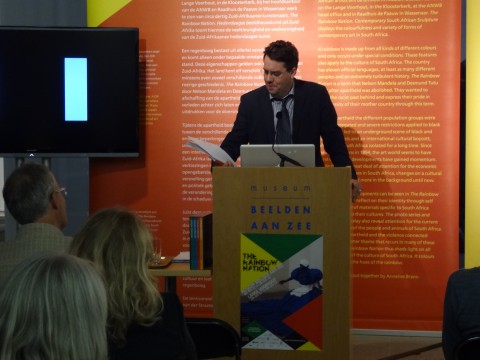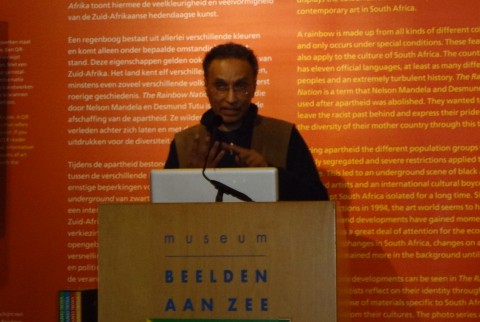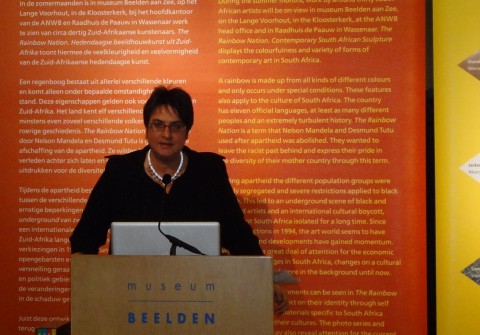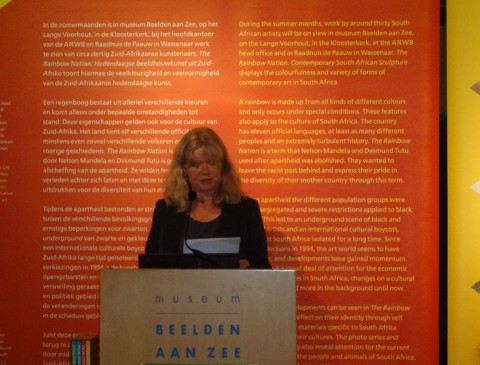This summer the Dutch Museum Beelden aan Zee curated ‘Rainbow Nation’, an exhibition of contemporary South African sculptures. In the final weekend the symposium ‘Mixing the Colors of the Rainbow’ was organised, to discuss the current status of South African art and art history. Head of exhibitions Dick van Broekhuizen started the evening with a short introduction to ‘Rainbow Nation’. To provide a contextual framework guest curator Annelies Brans-Van der Straeten referred to the historical time line of the new art historical encyclopaedia ‘Visual Century. South African Art in Context 1907-2007’. Editors of ‘Visual Century’ Gavin Jantjes and Lize van Robbroeck were invited to explain the realization of this historical overview and the accompanying struggles with methodology. Dutch art historian and curator Esther Schreuder was invited to present her view on South African art history.
The South African artist and editor in chief of ‘Visual Century’, Gavin Jantjes emphasised in his talk that the country lacked a concise record of South African art until 2010. Because a large amount of artworks were never documented, a substantial part of South African art remained invisible. A significant part of the 5.5-year research process was therefore to register and to find artworks that were not in the public realm or that had disappeared. Referring to a quote by Frantz Fanon (“Define yourself, or be defined”), Jantjes emphasised the importance to construct a history in the construction of identity.
The second speaker, editor of ‘Visual Century’ and currently associate professor at the University of Stellenbosch Lize van Robbroeck, experienced the dominantly white and European focused art history education herself when she studied at University of the Witwatersrand (Johannesburg). If books discussed South African art, they only included white artists. These art historical canons produced during the Apartheid regime now need to be reconsidered. Van Robbroeck continued on the methodological struggles the editorial team faced during the realization of ‘Visual Century’. She stated that previous formalist studies did (South) African art harm by producing a formalist and stigmatizing notion of primitivist art that celebrated ‘primitivist blackness’. Instead ‘Visual Century’ is based on a Foucauldian discourse analysis in which a multiplicity of voices is represented and context is included. Not only art historians were invited to write a contribution, the visions of artists, collectors, gallerists and critics were included as well. One of the difficulties of creating the historical overview is the possibility of duplicating a certain discourse. There is even a risk of reproducing the white dominance of the Apartheid by using certain customary words.
The third speaker of the evening, Dutch art historian and curator Esther Schreuder, responded critically to the editors of ‘Visual Century’, while demonstrating the complex relation between The Netherlands and South Africa. One of the main points of criticism she raised was the fact that they took 1907 as a starting point to define South African art history, thereby excluding previous artistic developments. While referring to Harold Szeemann, Schreuder suggests the methodology of the ‘creative archive’. Instead of chronology, art works (of past and present) are thematically structured by the act of association. One of her suggestions would be ‘the bed’ as this proves to be a reoccurring theme in the work of South African artists (from David Goldblatt to Marlene Dumas). Schreuder demonstrated this methodology with examples from the exhibition ‘Black is Beautiful’ she curated in Amsterdam in 2008. Finally she noted a lack of attention to international tendencies and interactions in the ‘Visual Century’ book series.
Lacking a central focus or a moderator, the event ended quite abruptly. Instead of a methodological debate, as one might expect from the different perspectives presented, the evening finished with a discussion on objects. Jantjes regretted that music is not included in the books and Marlene Dumas pointed out the practical difficulties of exhibiting sculpture in South Africa. Because of a lack of exhibition space and insurances many contemporary South African artists are not presented in their own country.




